
or the modern tech founder, fundraising and pitching can be challenging. However, entrepreneurs can find the funding they need with a strong seed-stage pitch deck. To bring you this fundraising and pitching guidance, we teamed up with NextView Ventures, a group of high-conviction, hands-on seed investors. They are championing founders redesigning the Everyday Economy to help spread the pitch deck they created for our founder community. We share their dream in striving to provide updated and top-notch resources for founders, so we wanted to get their take on advice for crafting a solid seed-stage pitch deck. Almost 5 years ago, NextView Ventures launched a pitch deck on Slideshare to provide a guiding example for founders looking to get inspired for their seed-stage pitch decks. It’s been viewed over 300,000 times and remains one of the most insightful resources they produced to date because they still hear positive feedback about it from the greater founder community.
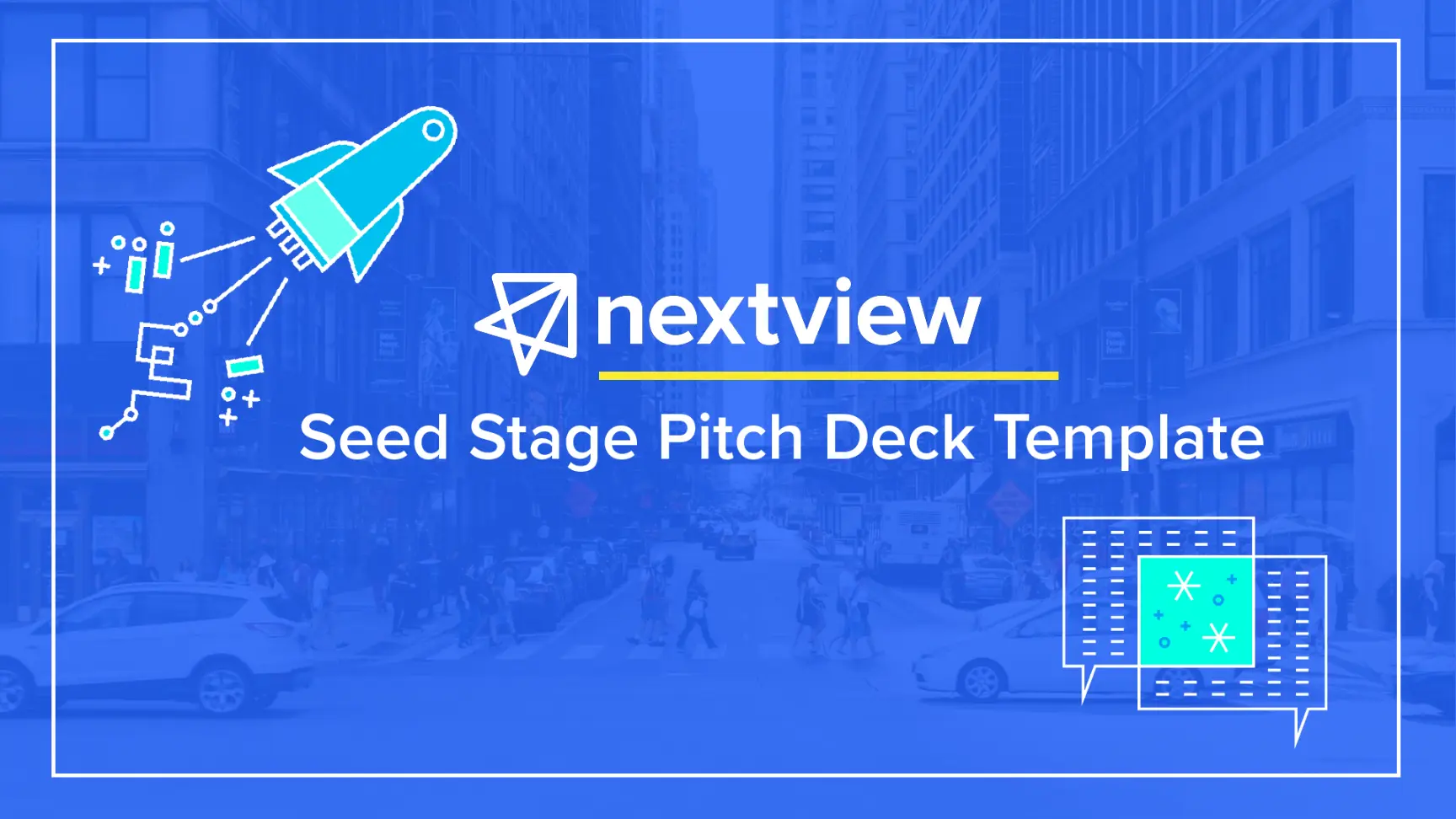
Download Template Here
Since they’re still receiving so many kudos amongst the entrepreneurial community, they decided to update it to fit the modern flow of pitches for founders not only looking to pitch to them, but also for the broader seed investor community. There are several templates like this that already exist, but NextView Ventures feedback found that those decks are:
- somewhat generic and not built specifically for seed-stage startups, which often require more art than science during the pitch;
- lack storytelling components and design and layout sensibility.
Modernizing the Seed-Stage Pitch Deck
1. The “Team” Slide
Of all of the slides in a pitch deck for VCs, the team slide should be the most straightforward. However, we’ve found that it’s frequently the most over-engineered, and often filled with extraneous information.
The purpose of the team slide is to quickly establish strong credibility. That’s it, then move on. Which is why we at NextView like to have it at the beginning of a slide deck. -David Beisel, Co-Founder & Partner at NextView Ventures
Yes, with Demo Day presentations founders generally weave a story about the problem and market, and then close with something like “we are the right team to do this.” But when you are having a real conversation with a real person, you always start by introducing yourself. And almost every investor flips to the team slide first anyway when they receive a deck, so it’s best to save everyone the trouble and put the team slide up front.
2. The “What Do You Do” Slide
After you’ve covered the team and have established some credibility around your company, it’s time to talk about the “what”. What does your company actually do? Be prepared to articulate your market problem in one simple sentence. Try to do so by including one killer stat or analogy that gets the point across in a powerful way.
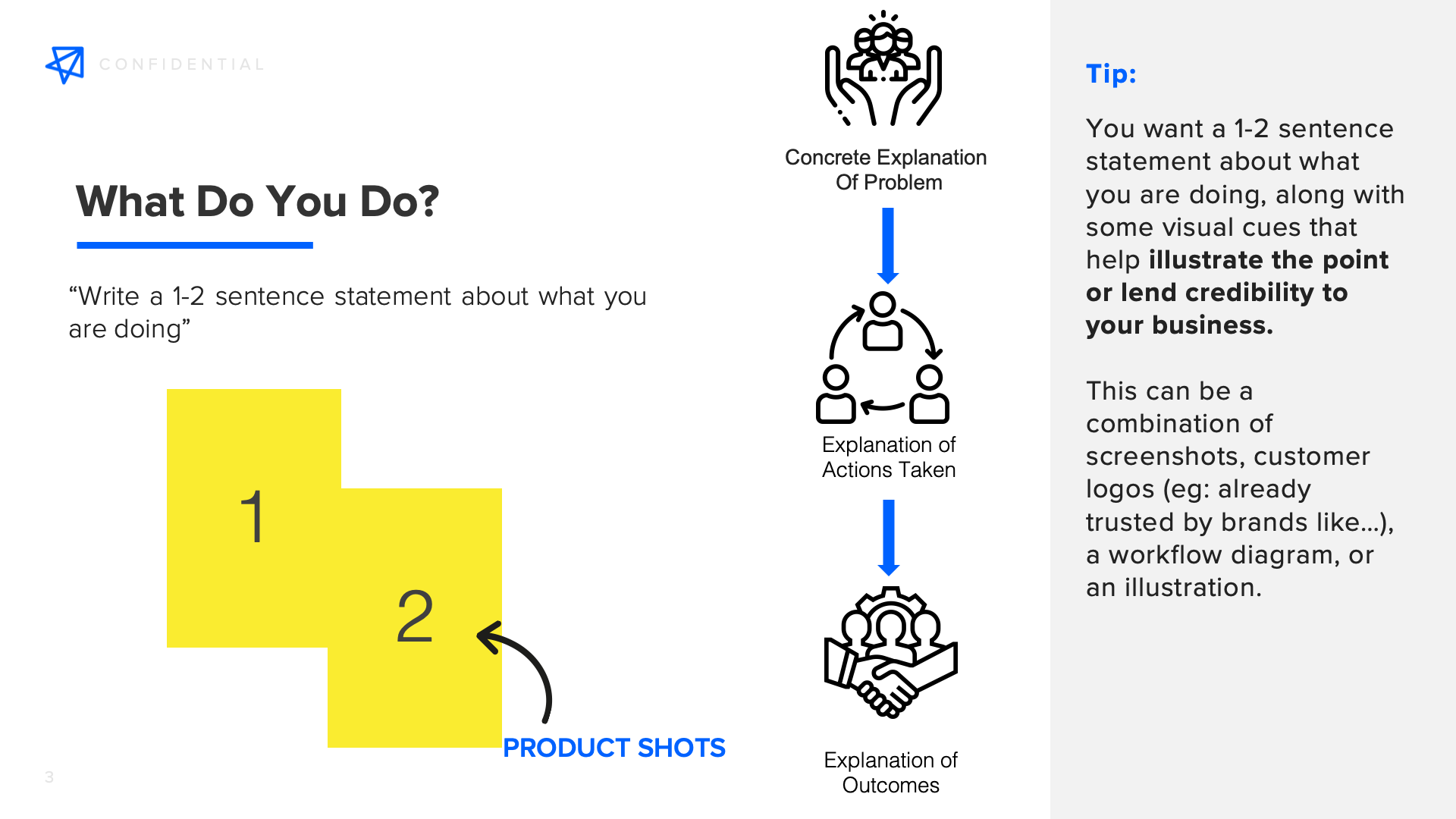
From there, you can ask the investor if they are familiar with the market or problem, or want to pause for more context. If they want to pause, flip to some appendix slides that lay out more market or industry information. If they don’t, the investor is still probably fairly ignorant of the market, but would rather you tell them what you do and then circle back to the market later. They are willing to take your claims about the market at face value, and can do confirmatory research or diligence later. The way to deal with the second problem is to be straightforward about it. “Our goal is to solve problem X, and our wedge into this market is Y.” You can then talk about what your product actually does (or is going to do) and how that will get the company into a strong position to achieve its broader ambitions down the road.
3. The “Is it Working” Slide
By now, you’ve described your team and the high-level overview of what your company does. Now it’s time to set the stage with the early traction you have.
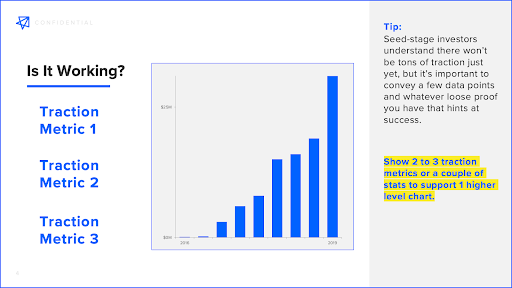
Seed stage VCs are realistic about how much traction a very raw company might have. At NextView we invest across the spectrum of seed-stage companies so roughly 1/3rd of the companies we invest in are pre-product, roughly 1/3rd are post-product but pre-revenue, and perhaps 1/3rd have some very early revenue. There’s no one chart or proof point that is relevant for every company, so you should think about what are the best ways to show “it’s working” for your company and go with that. See more examples or frameworks to consider here.
4. The “Why Does it Matter” Slide
Hopefully by this point in your deck, you have grabbed the investor’s attention based on your team, a crisp articulation of what you do, and some impressive proof points that things are working. The rest of the meeting is to add layers of depth to your story and to build more and more confidence and enthusiasm about your company. The next slide we recommend after the traction slides answer the questions of “why does it matter?” This is an opportunity to add the additional layers of market context that you held off on in slide 2. One could go into a deep rathole here talking about industry trends, but in general, we think there are three topics one could cover in these slides:

- Is this (or will this) be really big?
- Why now?
- Why is this strategic?
They expand across these 3 topics here. Now that you have hopefully deepened the investor’s excitement about why your company could be a huge success, you can shift to convincing them that you are destined to be the one who will win. You’ll want to talk about how you can be the best in the space next.
5. The “Can You Be The Best in The World” Slide
Although most pitch decks follow a logical progression, we think the best pitches are ones that evolve into spirited discussion after the first 10 minutes. That’s why this template is designed to hit the high points of the pitch early, with the latter portions of the deck adding additional layers of evidence to get investors excited about your company.
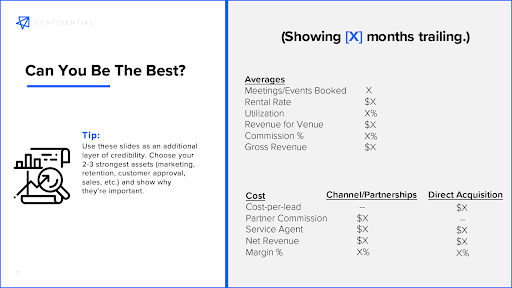
By the time you get to this point in the pitch, you have hopefully convinced the investor that your team is special, you are pursuing a market opportunity that matters, and have a product offering that is resonating in the market. The last section addresses a question that is tough to fully answer – will you be the winner?
You want to get the investor from a mindset of “this is pretty interesting' to “I really don’t want to miss this!' -Melody Koh, Partner at NextView Ventures
For any attractive opportunity, there is bound to be push back from incumbents, startups, and others in the space. Your job is to show that your positive momentum will lead to sustained market leadership. Some readers may interpret this as the time to show a slide of competitors. And for some businesses in highly crowded markets, this may be appropriate. But we actually find that a true competitor slide is best saved for an appendix, and the emphasis here should be on the things that make your company extra special.
6. The "Where Are You Going" Slide
So you’ve covered the “who”, “what”, “why”, & “when”. Now it’s time to discuss the “where”. As a seed-stage company, it is understandable to have a nascent (or non-existent) product and a barebone team relative to the great ambition of the company. As a result, investors usually need some help visualizing how you plan to get from point A to point B – this “roadmap” slide is where you can articulate your multi-year plan.
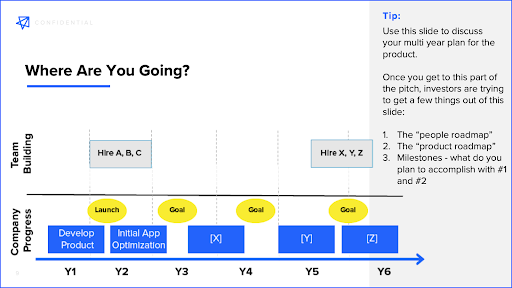
Once you get to this part of the pitch, investors are trying to get a few things out of this slide:
- The “people roadmap”
- The “product roadmap”
- Milestones – what do you plan to accomplish with #1 and #2
They expand across these 3 topics here. Once you talk through the roadmap and milestones, it sets the stage for the final slide (and the reason you’re meeting with investors) – how much you’re raising and what you plan to accomplish with this round of financing.
7. The “What Do You Want?” Slide
Here we are, at (one of) the final slides. The reason that you’re crafting the pitch deck, after all, is to raise funds. The closing slide in a pitch deck’s main section should be explicit about the ask. What do you want?
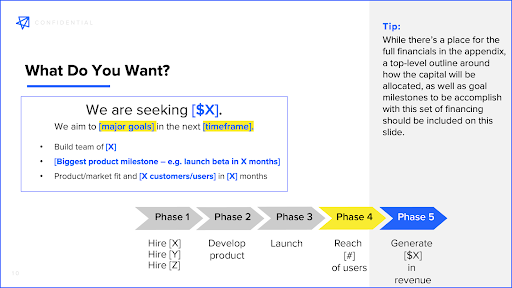
It’s to a founder’s advantage to be up front and directly state how much capital you’d like to ideally raise in this round. Personally, we prefer to share a (tight) range (e.g. $1.5m - $2m) rather than a specific figure. It shows some flexibility and allows for different investors (depending on their own fund size and strategy) to see a larger or smaller number depending on how they’d potentially fit into the round most easily. (Plus, it allows some wiggle room on being able to declare success even if the actual fundraising target isn’t reached.) The purpose of this ask slide is to demonstrate that you’ve given critical thought about the amount of capital which you’re raising, what you’re planning on doing with it, and what you will have to show for it as you’re approaching the need for another subsequent fundraising round. For a potential investor, it answers the questions of how much and why investing now is the right time. Read more about other sets of information they recommend in their article here, along with how to take advantage of the Appendix.
The Takeaway
This slide-by-slide breakdown of the ultimate seed-stage pitch deck will help today’s tech founders get the funding they need to grow their business. The NextView Ventures guide covers all the basics you need to get your startup off the ground, and towards your goals.





